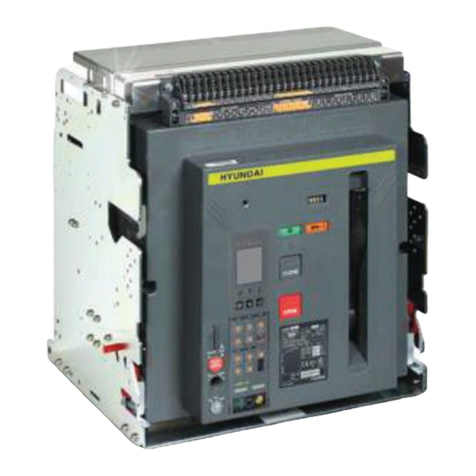Technical Data
기술적 데이터
02
8<< Vacuum Circuit Breaker Instruction Manual
2.3 Multiple Auto-Reclosing
HVF & HAF circuit breakers are capable of auto-reclosing
and can also be used for multiple reclosing for the
following operating sequence
O-0.3s-CO-15s-CO-15s-CO..... (O: tripping; C: closing)
2.4 Interlock Mechanism of the Draw-Out Type Breaker
The draw-out type circuit breaker has an interlock
mechanism which prevents trouble due to misoperation.
The sensing parts check the position of the circuit breaker
and prevent it from closing if the associated disconnector is
not allowed for safe operation.
2.5 Closing (Y9) and Anti-Pumping (K1)
When closing authorization is applied through terminals no.
6 & 7, Solenoid Y9 unlatches the closing spring, and thus
closes the circuit breaker electrically. Immediately after the
breaker closes, Aux. S/W, S1 the closing circuit, and limit
switch S3 and anti-pumping relay K1 switch affect to Y9 so
that they can not be reactivated until the continuous
closing command is interrupted.
Thus the breaker can meet the IEC requirements for anti-
pumping and trip-free opeation. At the same time, the
contact pressure spring is compressed properly to maintain
sufficient contact pressure on the moving contact of the
vacuum interrupters while the breaker is in the closed
position, and the tripping spring is compressed for the
opening operation.
2.6 Open Solenoid (Y1)
When the opening command is applied, the tripping spring
is unlatched by the trip solenoid Y1 and the force turns the
torque to rotate the brake shaft to make the opening
position. Immediately after the breaker is open, the
indicator displays the open state and Aux. S/W, S1 open
the opening circuit.
2.7 Auxiliary Switch (S1)
The standard auxiliary contacts for external connection are
composed of 4NO+4NC. These contacts are wired to the
control jack (XO).
Rated Insulation Voltage: AC/DC 250 V
Continuous Current: 10 A
Making Current: 30 A
Switching Current: 2 A at DC 220 V, =20 ms
The maximum connection 10NO+10NC is available on request.
2.3 다중 자동 재투입
2.4 인출형 차단기의 인터록 장치
2.5 투입(Y9)과 재투입 방지 회로(K1)
2.6 트립 솔레노이드(Y1)
2.7 보조 스위치(S1)
Misoperation or carelessness may result in
serious injury or property damage.
With the breaker closed, the draw in & out operation is
impossible. Do not push too hard on the breaker under
improper condition.
오조작, 또는 부주의가 중상 혹은 재산 피해를 일으킬 수 있습니다.




























